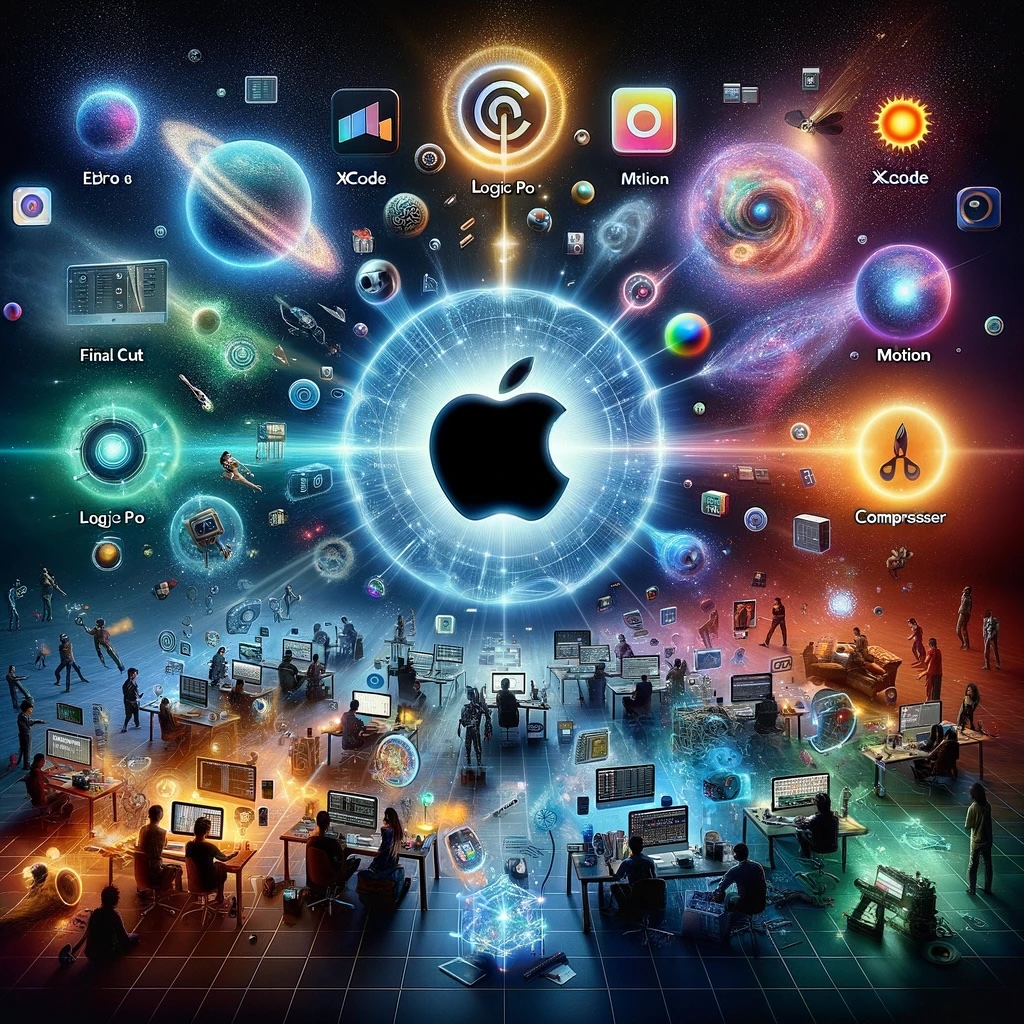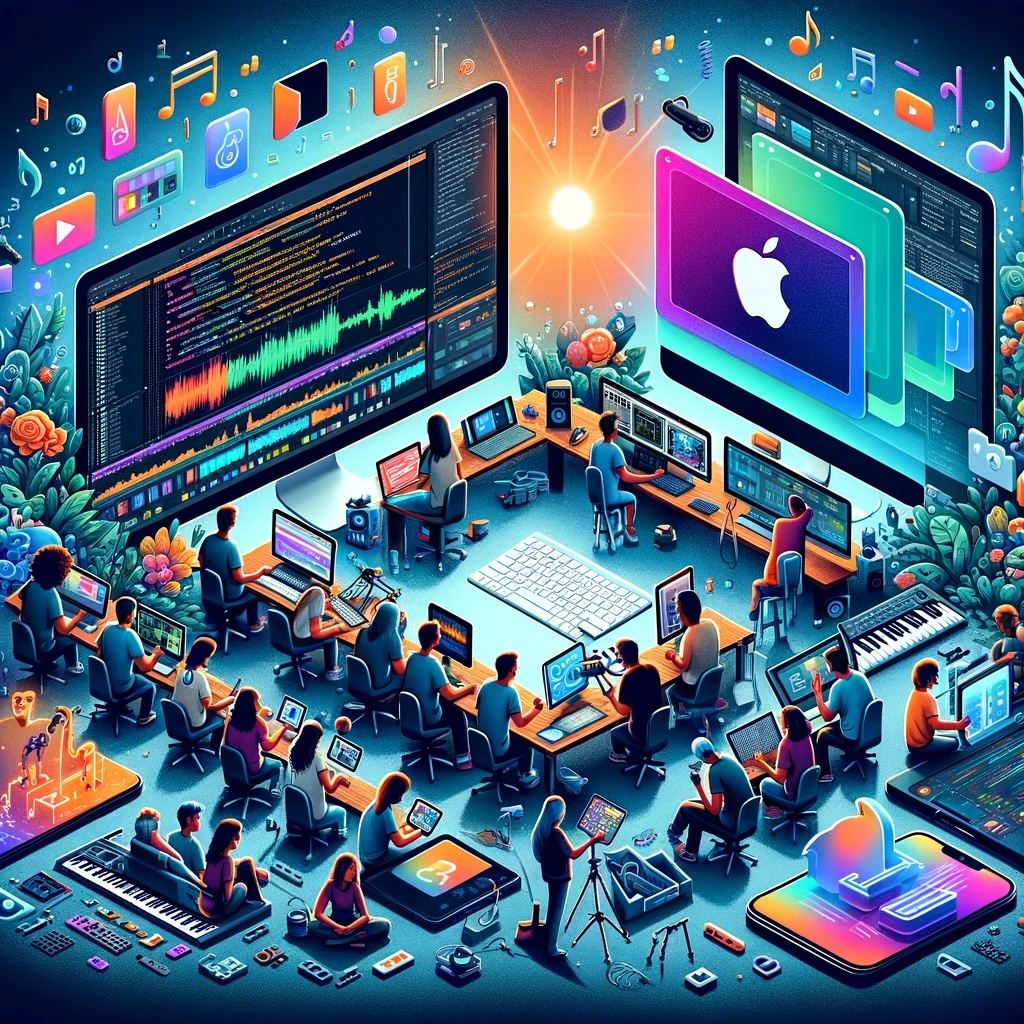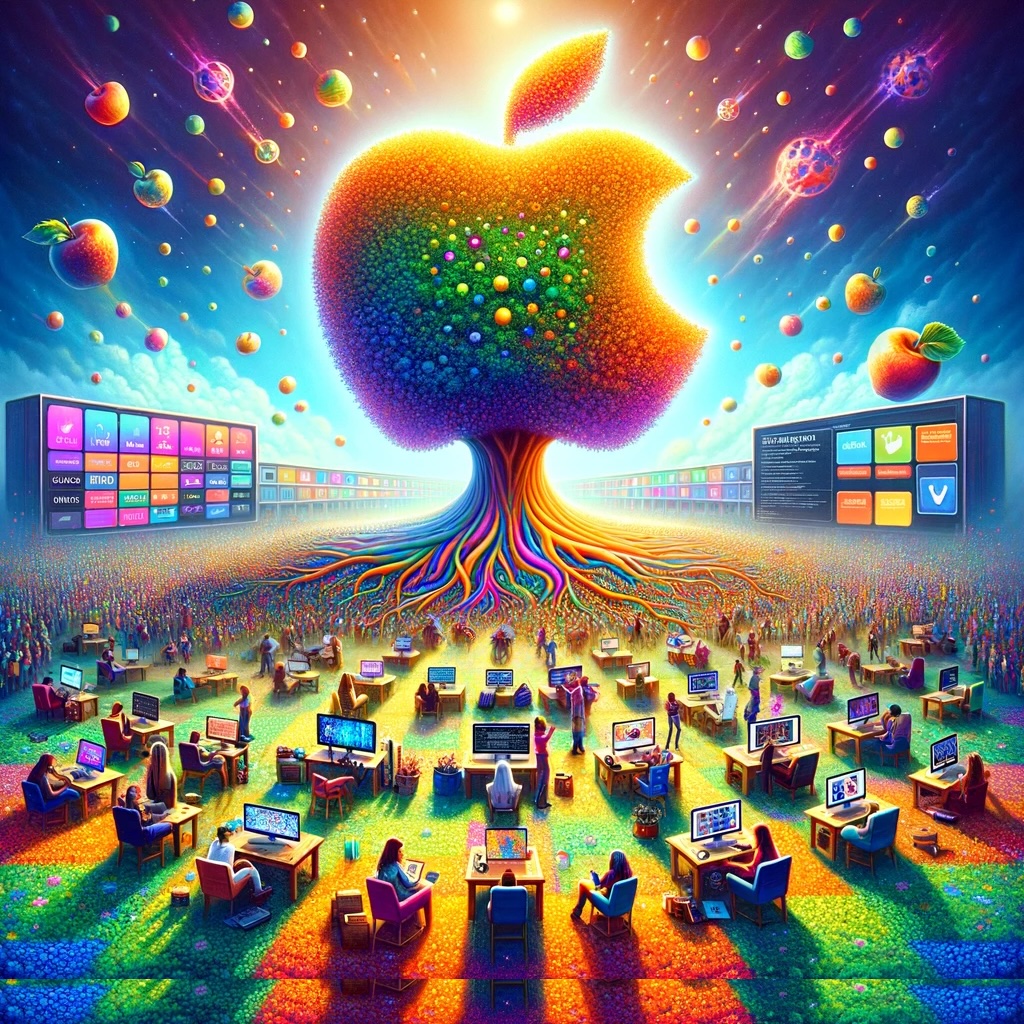In the world of technology and innovation, few companies have left an indelible mark quite like Apple. From the revolutionary introduction of the Macintosh in 1984, signaling the dawn of the personal computing era, to the game-changing launch of the iPhone in 2007, Apple has consistently pushed the boundaries of what technology can achieve. My own journey with Apple began with awe and admiration for how its products seamlessly blend design and functionality, profoundly impacting my work and career. This personal connection to Apple’s ecosystem is not just about the devices but the ethos of innovation, user-centric design, and a relentless pursuit of excellence that Steve Jobs ingrained in the company’s DNA. As we delve into Apple’s potential evolution into a $4 trillion creative platform, it’s this foundational spirit that suggests a bright future for creators and innovators worldwide.

Apple proves it has Vision
Setting the stage for Apple’s future is its latest groundbreaking innovation: the Apple Vision Pro. Introduced as Apple’s first spatial computer, the Vision Pro epitomizes decades of Apple’s experience in designing high-performance, wearable devices. It’s an ambitious product that integrates advanced technology into a compact, elegant form, offering a mixed-reality experience unlike any other. With ultra-high-resolution displays and an advanced Spatial Audio system, the Vision Pro can transform any space into a cinematic experience or a 3D interactive environment. This device opens up new horizons for content creation, allowing creators to immerse themselves and their audiences in experiences that were previously unimaginable. The introduction of the Apple Vision Pro not only underscores Apple’s continued commitment to innovation but also sets a new benchmark for what’s possible in the realm of digital creation and interaction.

Unification of Tools
Expanding on the vision of transforming Apple into a $4 trillion creative powerhouse, a comprehensive strategy must encompass the full suite of Apple’s creative and development tools. This includes not only flagship applications like Final Cut Pro, Logic Pro, and Xcode but also Motion, Compressor, ARKit and the plethora of other frameworks Apple has meticulously built over the years. By unifying these tools into a cohesive creative platform, Apple could offer an unmatched ecosystem that caters to every aspect of digital creation and interaction.
Imagine a platform where video editors, graphic designers, music producers, app developers, and XR creators can seamlessly collaborate and innovate. With Motion and Compressor, video professionals could create stunning visuals and effects, then efficiently encode and distribute their work. ARKit, coupled with Apple’s powerful frameworks, would enable developers to craft immersive augmented reality experiences that could transform education, entertainment, and retail.
Integrating these tools into a singular, streamlined platform would not only simplify the creative process but also foster a community of creators who could push the boundaries of what’s digitally possible. Such a platform would serve as a foundation for next-generation content creation, enabling seamless integration across devices and unlocking new creative potentials.
This holistic approach to unifying Apple’s creative and development tools underlines the company’s commitment to innovation, privacy, and a creator-owned future. It positions Apple not just as a provider of premium hardware and software but as a leader in shaping the future of how we create, share, and experience digital content. By leveraging its entire ecosystem, Apple can empower creators in unprecedented ways, catalyzing a new era of digital artistry and technological advancement.

Platform Benefits
The strategic decision to open up Apple’s professional-grade tools as part of its ecosystem carries the potential to redefine the creative landscape. By making tools such as Final Cut Pro, Logic Pro, Motion, Compressor free like Xcode, ARKit GameKit and more accessible to a broader audience, Apple could significantly enhance the diversity and quality of content and experiences within its marketplaces. This inclusivity would not only democratize high-quality content creation but also attract a wider array of creators to the Apple platform.
The benefits of this approach are manifold. For starters, it would foster a vibrant community of content creators, ranging from filmmakers and musicians to app developers and XR designers. This diversity would, in turn, enrich the Apple ecosystem with a wider variety of apps, games, music, movies, and educational content, making Apple devices even more indispensable to consumers.
Additionally, by opening up its professional tools, Apple could establish itself as the go-to platform for creative professionals and hobbyists alike. This would likely lead to an increase in the adoption of Apple products, as creators invest in the hardware that offers them the best tools for their craft. Additionally, a more robust ecosystem of tools, content and apps would enhance user engagement, keeping customers within the Apple ecosystem and driving further revenue through both hardware sales and content purchases.
In general, the platform benefits of making Apple’s professional-grade tools free are clear: it would not only solidify Apple’s position as a leader in technology and creativity but also stimulate innovation and content creation across the board. This strategy aligns perfectly with Apple’s commitment to privacy, user empowerment, and creating a rich ecosystem where creators of all levels can thrive. As a result, Apple could unlock new growth opportunities, paving the way to achieving a $4 trillion valuation by redefining the future of digital creativity and interaction.

Shift in Monetization Strategy
In envisioning Apple’s journey towards a $4 trillion valuation, a pivotal shift in its monetization strategy emerges as a critical component. Traditionally, Apple has levied significant fees on sales within its ecosystem, from app purchases to subscriptions. However, by recalibrating this approach—reducing the financial burden on creators and instead enriching the ecosystem’s value—Apple stands to ignite a renaissance in content creation and innovation.
This strategic shift would involve lowering the barriers for creators to distribute and monetize their work on Apple platforms. By reducing the commission rates on the App Store and offering more favorable terms for content creators, Apple could significantly enhance the attractiveness of its ecosystem to a broader range of innovators. This change would not only incentivize more developers, artists, and educators to choose Apple as their primary platform but also encourage existing creators to invest more resources into enhancing their offerings.
The benefits of this approach extend beyond mere increases in the quantity of content. A more supportive financial model would enable creators to focus on quality, innovation, and experimentation. Freed from the constraints of high fees, developers could afford to take risks on novel ideas, artists could produce more engaging and diverse works, and educators could develop more comprehensive and interactive learning materials.
This shift would foster a more vibrant and diverse creator community. By supporting creators from various backgrounds and disciplines, Apple could facilitate a richer, more inclusive ecosystem. This diversity would not only reflect Apple’s commitment to empowerment and creativity but also attract a wider audience to its platform, enhancing user engagement and satisfaction.
In essence, by moving away from heavily taxing network contributors and instead offering more value through its ecosystem, Apple could cultivate a thriving community of creators. This community would be the lifeblood of Apple’s ecosystem, continuously enriching it with innovative apps, captivating content, and transformative experiences. Such a vibrant ecosystem would not only solidify Apple’s position as a leader in technology and creativity but also drive sustainable growth, paving the way for Apple to achieve and possibly exceed a $4 trillion market valuation.

Commitment to Privacy and User-Owned Data
In the digital age, where data is often likened to the new oil, Apple’s steadfast commitment to privacy and user-owned data stands as a beacon of ethical leadership. This principled stance is not just a policy but a core component of Apple’s identity, distinguishing it sharply from competitors. By doubling down on its privacy-first approach, Apple not only meets the growing consumer demand for data protection but also elevates its platform as the more ethical alternative in the tech landscape.
Apple’s dedication to privacy manifests through its robust data protection measures, transparent policies, and the empowering of users with control over their personal information. Features such as App Tracking Transparency and end-to-end encryption on iMessage and FaceTime are prime examples of Apple’s commitment to safeguarding user data. Such measures reassure users that their creative content, personal information, and digital interactions are secure and respected, fostering a trust-based relationship between Apple and its global user base.
In the context of creating a unified creative platform, this commitment to privacy and data ownership becomes even more crucial. As creators produce and share more content across Apple’s ecosystem, the assurance that their intellectual property and personal data are protected is paramount. This environment not only nurtures creativity but also encourages a wider range of creators to join the Apple ecosystem, knowing their work and privacy are in safe hands.
Moreover, by positioning itself as the ethical choice, Apple can attract consumers and creators who are increasingly wary of platforms that commodify user data for advertising or other purposes. This alignment with consumer values on privacy not only strengthens Apple’s market position but also serves as a competitive advantage in attracting quality talent and content to its platform.
In sum, Apple’s unwavering commitment to privacy and user-owned data is not merely a feature of its ecosystem; it’s a foundational pillar that could significantly contribute to its journey toward a $4 trillion valuation. By upholding these values, Apple not only aligns with the growing demand for data protection but also sets a new standard for what it means to be an ethical leader in the technology industry. This approach fosters a safer, more creative, and more vibrant community of users and creators, propelling Apple forward in its mission to empower individuals through technology.

Contrast with Competitors
In the rapidly evolving tech landscape, Apple’s strategic focus on empowering creators offers a stark contrast to the ambitions of competitors like Facebook, which has pivoted towards owning digital realms such as the metaverse. This distinction is critical, as it underscores a fundamental difference in philosophy between the two tech giants. While Facebook (now Meta) envisions a future where it controls vast, immersive digital spaces, Apple is positioning itself as an enabler of individual creativity and innovation.
Apple’s emphasis on providing a unified creative platform, equipped with professional-grade tools and a commitment to privacy, positions it uniquely in the tech ecosystem. Rather than seeking to dominate a digital frontier, Apple aims to empower its users with the tools and freedom to create their own content, experiences, and applications. This approach not only fosters a more inclusive and diverse creative community but also aligns with Apple’s long-standing ethos of putting the user at the center of everything it does.
In contrast, Facebook’s pursuit of the metaverse represents a centralized vision of digital interaction, where the platform itself becomes the primary mediator of experiences and transactions. While this offers exciting possibilities, it also raises concerns about privacy, data ownership, and the concentration of power in the digital age. Apple’s focus on empowering creators with tools and a secure platform offers an alternative vision, one where individuals retain control over their creations and data.
By highlighting this commitment to empowerment and privacy, Apple can differentiate itself in the eyes of consumers and creators alike. This differentiation is not merely a matter of marketing but reflects a deeper philosophical stance on the role of technology in society. Apple’s approach suggests a future where technology serves to amplify human potential, creativity, and freedom, rather than constraining them within a single, corporate-owned digital ecosystem.
This contrast with competitors like Facebook not only strengthens Apple’s brand identity but also resonates with a growing segment of the population concerned about privacy, data sovereignty, and the ethical implications of digital platforms. In embracing this role, Apple not only sets itself apart in the competitive landscape but also lays the groundwork for a sustainable, creator-driven future that could significantly contribute to its goal of reaching a $4 trillion valuation.

Legacy of Innovation
Apple’s journey towards becoming a $4 trillion creative platform is deeply intertwined with the legacy of its co-founder, Steve Jobs, whose vision for technology was always about empowering individuals to make a dent in the universe. Jobs’ philosophy of innovation and creativity remains a guiding light for Apple, emphasizing the potential of technology to empower people to create, innovate, and express themselves in unprecedented ways. By invoking this legacy, Apple can position itself not just as a technology company, but as a champion of a creator-owned future, where individuals are encouraged and enabled to own their creations and innovations.
Steve Jobs famously said, “Technology alone is not enough—it’s technology married with liberal arts, married with the humanities, that yields us the result that makes our heart sing.” This perspective is more relevant today than ever as Apple stands on the brink of unifying its ecosystem to support creators across various domains. By providing tools that integrate seamlessly across devices and platforms, Apple empowers creators with the freedom to bring their visions to life, from the initial spark of an idea to the final masterpiece.
Apple’s commitment to this vision is evident in its continuous innovation in hardware and software, making sophisticated technology accessible and user-friendly. This approach democratizes content creation, making it possible for more people to participate in the creative process, regardless of their technical expertise. By doing so, Apple not only honors Steve Jobs’ legacy but also builds upon it, pushing the boundaries of what technology can achieve in service of creativity and innovation.
Championing a creator-owned future, Apple sends a powerful message about the value of intellectual property and the importance of supporting creators in maintaining control over their work. This stance not only differentiates Apple from its competitors but also aligns with a broader cultural shift towards recognizing and valuing the contributions of creators in the digital age.
In essence, Apple’s legacy of innovation, inspired by Steve Jobs, provides a solid foundation for its vision of a unified creative platform. By empowering individuals through technology, Apple can inspire generations of creators to innovate and own their futures. This commitment not only pays homage to Jobs’ vision but also propels Apple towards a future where technology continues to make our hearts sing, driving the company towards its $4 trillion valuation with creativity and innovation at its core.

